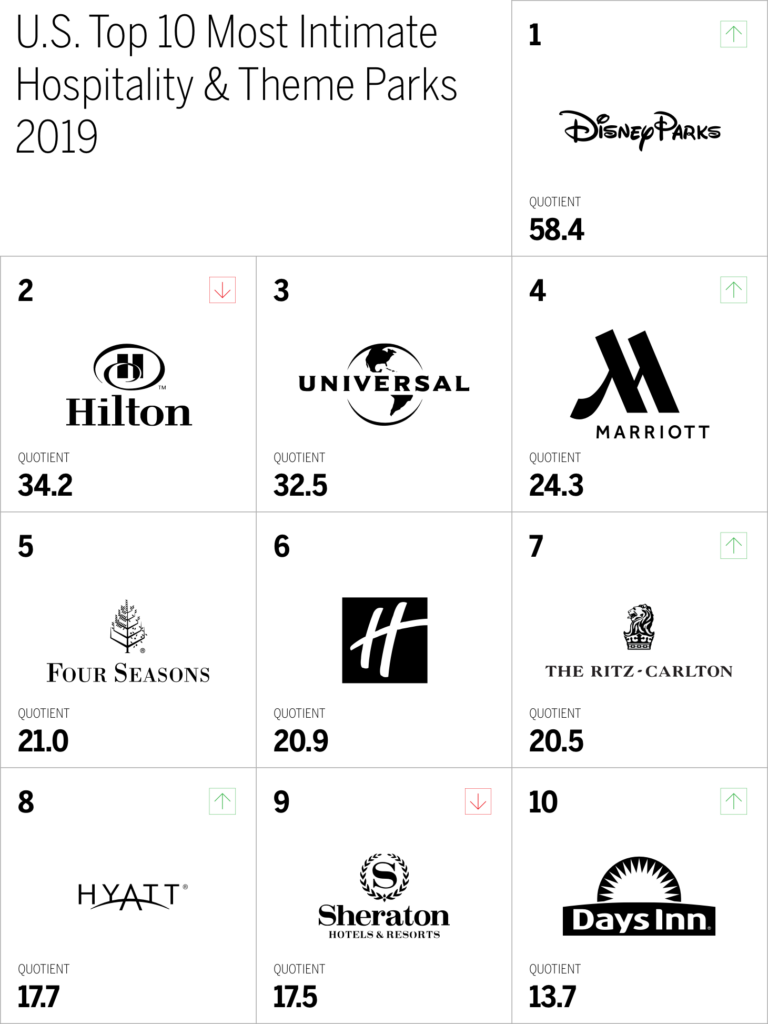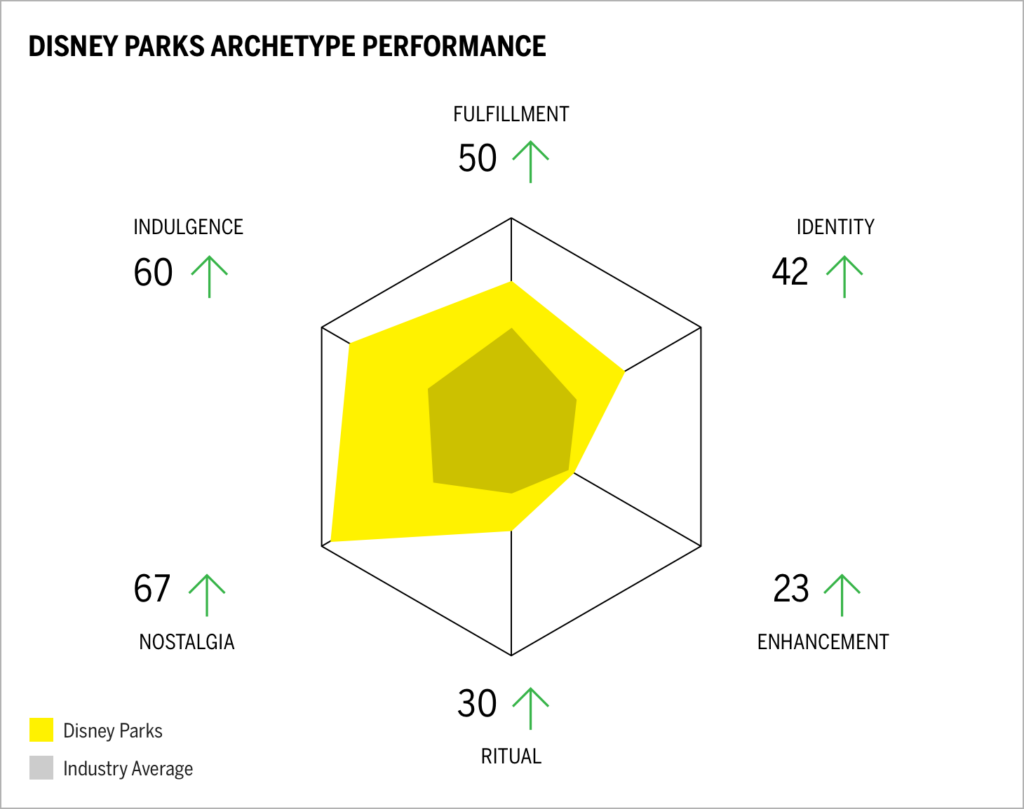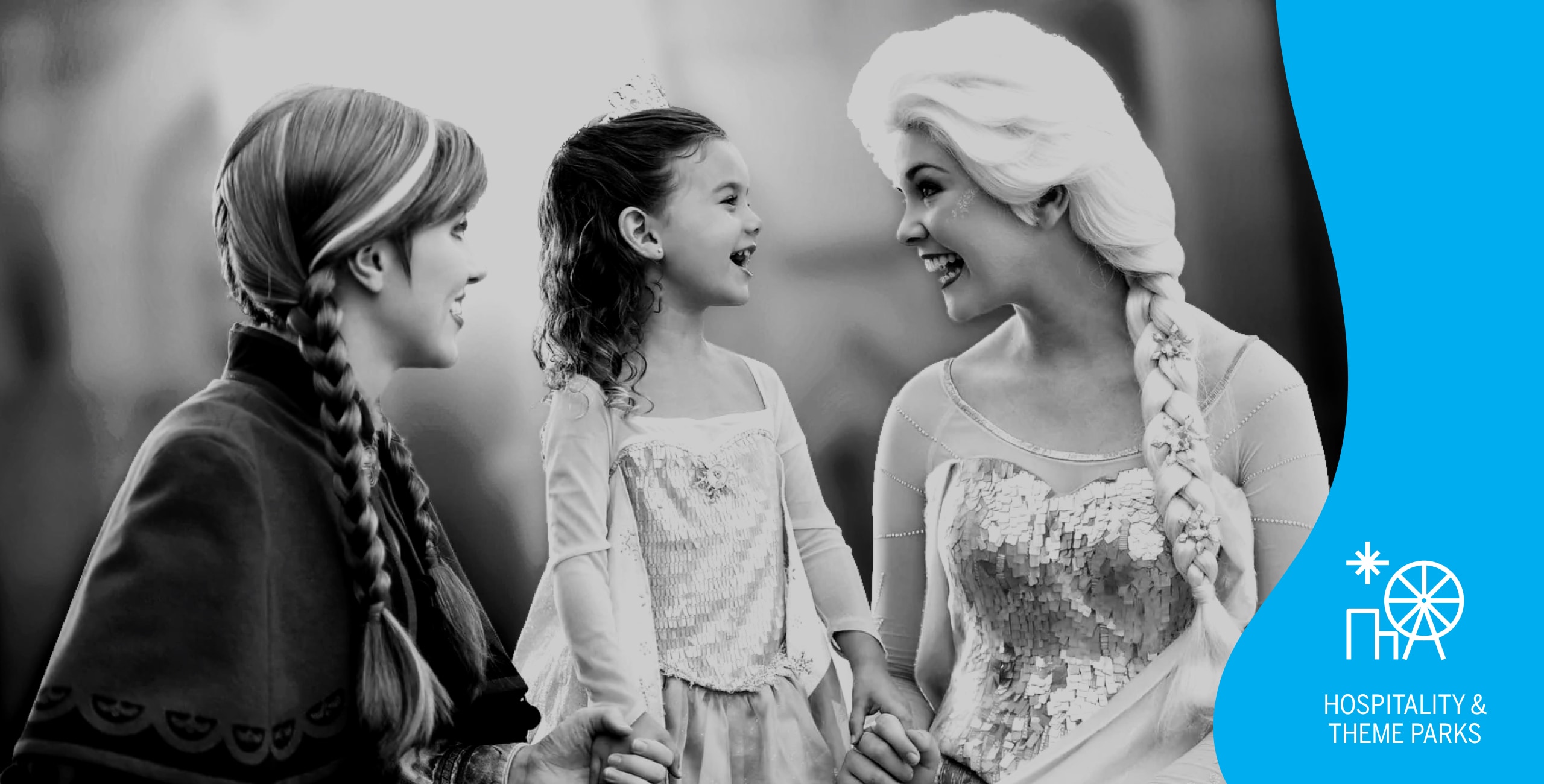Overview
- Disney Parks is the #1 brand in the hospitality & theme parks industry by a significant margin of 24.2 points
- The brand leads the industry in five of the six Brand Intimacy archetypes and is most associated with the nostalgia and indulgence archetypes
- A range of demographic groups are intimate with Disney Parks, especially users who are 35 or older, women, and users with incomes of $75,000 or more
In the hospitality & theme parks industry, one highly intimate brand stands out: Disney Parks. With a Brand Intimacy Quotient of 58.4, Disney Parks is the top brand in the industry by a significant 24.2 points (followed by Hilton). This gap between the #1 and #2 brands is larger for hospitality & theme parks than it is in any other industry. Because Disney Parks has done such an effective job at connecting with consumers, we are walking through our key findings about the brand to unpack and understand its enormous success.

Close ties to the top
The most obvious advantage for Disney Parks is its tie to the #1 brand overall: Disney. After ranking fifth last year, Disney jumped to the top of our study.
We explored Disney’s success in a recent article, and one of our key findings was that it has the largest percentage of customers in the deepest stage of Brand Intimacy: fusing. A user in the fusing stage is inexorably linked and co-identified with a brand; their identity begins to merge with that of the brand, becoming a form of mutual realization and expression. Because so many of Disney’s users identify so strongly with the brand, its parks are popular and beloved destinations for many consumers.
A range of associations
One way to understand how Disney Parks connects with consumers is through the Brand Intimacy archetypes. These archetypes are six patterns that identify the character and nature of ultimate brand relationships.

In the hospitality & theme parks industry, Disney Parks is the #1 brand for five of the six archetypes (all but enhancement), with an emphasis on nostalgia and indulgence. The nostalgia archetype focuses on memories of the past and the warm feelings associated with them, while the indulgence archetype characterizes a brand as having a close relationship with the user that is centered on moments of pampering and gratification. Nostalgia and indulgence are natural strengths for Disney Parks because the brand leverages beloved childhood characters and stories and does so in a theme park environment that provides a highly indulgent experience.
Theme parks are built to create strong associations, which would explain why Disney Parks does so well in so many archetypes. They provide 360-degree experiences that engage consumers across their senses under a single, unified brand. For an example of the sheer volume and range of experiences Disney Parks surrounds its guests with, Disney World’s Magic Kingdom Park currently offers 40 attractions, 38 restaurants, 32 entertainment experiences, and 22 tours and events. This multitude of experiences ensures that guests are constantly connecting with the brand through every activity, meal, and show. From Disney Parks, other brands can learn important lessons about how to create immersive and meaningful experiences that connect deeply with consumers.
Fun for the whole family
It’s no secret that Disney Parks are built for family experiences, even if they mainly exist for the benefit of children. Whether it’s because of nostalgia, a love of spending time with their kids, or the various adult attractions at Disney resorts (e.g., golf courses, spas, and bars), users older than 35 have some of the strongest emotional connections with the brand.
Disney Parks performance across key demographic groups

Women and consumers with incomes of $75,000 or more are two groups that are highly intimate with the brand, with each having an average Brand Intimacy Quotient of 62.7, which is higher than the brand’s overall average of 58.4. What’s most notable about the charts above is that Disney Parks is able to attain high levels of Brand Intimacy across a range of demographic groups; it’s not exclusively for women or men, and it’s able to connect with consumers of different ages and incomes. This ability to connect across demographic groups is an enormous asset for Disney Parks, especially because the brand is a family destination. It’s advantageous to be able to cater to a range of consumers so it can provide experiences that satisfy the whole family, and it seems to have done so expertly.
Positioned to prosper
Disney Parks is a brand on the rise—its Brand Intimacy Quotient jumped over 24 points since last year. Additionally, the brand’s ability to bond with users across age groups has allowed it to remain relevant to different generations. Disney Parks has improved its score with millennials since last year from an already-impressive 47.9 to 51.4, which may suggest that younger consumers will grow more intimate with the brand as they age.
Disney Parks is also destined to expand via its parent company’s media empire. We can see this evolution happening in real time with the opening of “Pandora–The World of Avatar” in 2017 and “Star Wars: Galaxy’s Edge” set to open this August. As future generations fall in love with Disney’s franchises (both new and old), they’ll be able to experience them in the real world, and this could have serious implications for Brand Intimacy, given that younger consumers are known to value experiences over products.
It’s also worth noting that millennials have stronger connections to the media & entertainment industry than older consumers do (53.3 vs. 45.7). If younger consumers have stronger attachments to media, Disney Parks will have a greater ability to leverage that media to craft experiences for younger audiences. As the emotional value of media & entertainment increases (which it appears to be doing), so too does the value of the theme parks that bring that content to life.
Conclusion
Disney Parks is an expert innovator when it comes to creating magical experiences. It has a strong capacity for Brand Intimacy because it leverages its ties to the Disney brand, designs destinations that create strong associations, and caters to a range of demographic groups. Going forward, the brand is positioned to maintain or improve its performance as new generations grow up consuming Disney content and new franchises provide opportunities for park updates and expansions.
Although Disney Parks is unique and linked to Disney, it provides relevant insights for other brands and can teach us important lessons about crafting branded environments of all kinds. Disney Parks shows us how to leverage consumers’ emotional attachments to products and services to create destinations that strengthen their bonds with brands and bring Brand Intimacy to life.
Check out our annual study and rankings of intimate brands. Visit our most recent rankings of intimate famous figures—BFF. Our Amazon best-selling book is available at all your favorite booksellers. To learn more about our Agency, Lab, and Platform, visit mblm.com.
